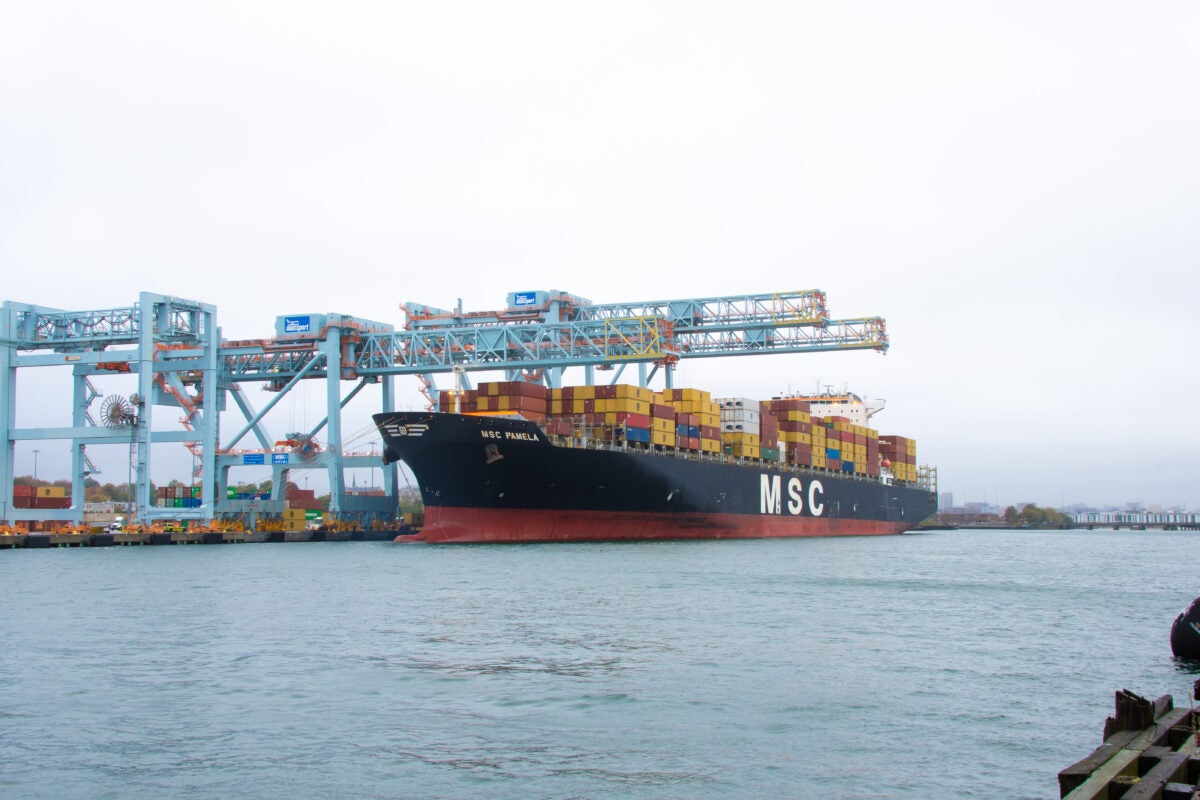
New England aims to build upon its shipping prowess as the Port of Boston celebrates a number of facility improvements to serve bigger ships from the world’s busiest shipping lines.
The Massachusetts Port Authority (Massport) is in the final stages of its $850 million project to become “big ship ready” as it has dredged Boston Harbor; purchased three additional ship-to-shore container cranes; constructed a berth to accommodate vessels carrying 14,000 twenty-foot equivalent units; and built a freight corridor to eliminate commercial truck traffic through surrounding neighborhoods.
“We had the foresight over a decade ago to see that the Port of Boston needed to upsize, modernize and revitalize its container terminal in order to stay competitive as an East Coast port, especially with the expansion of the Panama Canal in 2016 that’s now accepting larger vessels,” said Lauren Gleason, Massport’s deputy port director of business development.
The ever-increasing size of container ships has spurred premier ports to follow suit, which means everything must be bigger — and deeper. Massport, the Army Corps of Engineers and the commonwealth of Massachusetts initiated a $350 million dredging project to deepen the harbor to 47 feet and the waters alongside berths to 50 feet and to expand the harbor’s turning basin to 1,725 feet.
The three new ZPMC-built cranes, which began service in September, are 205 feet tall, have a towering 163-foot lift height and can reach 22 container rows across a ship. In all, this enables the port to handle vessels carrying up to 14,000 TEUs.
The cranes were positioned just west of existing berths to distance the port from the flight path of nearby Logan International Airport, which Massport also owns and operates. The Conley Terminal’s cranes, which Gleason describes as some of the largest low-profile cranes in the world, were specially engineered to have horizontal booms to adhere to FAA air draft restrictions.

Massport hopes its upgrades will attract new services to the port. Weekly services to Northern Europe and North China are already provided by Mediterranean Shipping Co. and the Ocean Alliance, a space-sharing consortium among CMA CGM, OOCL, Evergreen and Cosco, but Gleason said the port is eyeing a Southeast Asia service from Vietnam, Malaysia, Thailand and India.
“We believe there’s the potential for close to 175,000 TEUs to come through Boston directly if there were a Southeast Asian service,” Gleason said, adding that the service would likely be routed through the Suez Canal.
Landside developments were also made to ensure the port can handle increased container volumes. A total of $75 million was invested to construct a freight corridor to eliminate commercial traffic through South Boston’s residential streets. Completed in 2017, the freight corridor provides more efficient access to the interstate highway system. Gleason said this access paired with 30-minute truck turn times in the terminal makes it an easy place to do business for truckers.
“Before, it was not an ideal scenario,” Gleason said. “We wanted to be a good neighbor to the residents that were living there that certainly didn’t want to see trucks on their streets at all hours of the day, so it was really great to form a partnership with the community to make sure freight traffic was moved away from the residential neighborhoods.” Gleason said Massport worked with the community to also construct a public park for local residents that serves as a buffer between the terminal and the neighborhood.
The investments in Conley Terminal benefit the New England importer and exporter community and the broader economy overall. Gleason noted that the Port of Boston generates $8.2 billion in annual economic impact, supporting 9,000 jobs directly and 66,000 indirectly across New England.
While the goal is to expand connections to the global economy, Gleason said that Massport will always retain a regional port strategy.
“We handle over 2,500 businesses through the port annually, and we know most of those businesses on a first-name basis as do these businesses know my team by our first names,” Gleason said. If there’s an issue, she said that importers aren’t calling a general help number but can call her or the business development team directly.
“It’s that personalized touch that is really driving a lot of retailers and shippers, both regionally as well as nationally, to relook at regional ports in order to keep their supply chain fluid, especially as they consider 2022, when I think a lot are expecting congestion to continue.”
John Westwood, director of product and procurement at Gemini Shippers Group, is a strong advocate for the use of regional ports.
“In the current operating climate, it’s clear that having the optionality to use regional ports as an alternative gateway increases supply chain resiliency and reliability,” Westwood said. “Regional ports are often less congested and can provide value through lower port-to-door drayage expenses, reduced empty miles and a reduction in overall greenhouse gas emissions.
“Boston provides a strategic advantage to our New England customers. The lack of road infrastructure and congestion on the Interstate 95 corridor continues to make the movement of containers from New York an expensive challenge. Rising fuel prices, driver shortages and endless traffic can be mitigated for many of our New England customers when they ship through the Port of Boston.”
Jennifer Mehigan, Massport’s director of media relations, detailed the port’s goal to ensure that congestion won’t be an issue in the coming years. As other large gateways struggle to handle the increased container volume, Mehigan said that Massport is in the process of expanding its capacity to 600,000 TEUs.
“The ships are going to continue to get bigger, which creates more capacity for our customers,” Mehigan said. “But our customers have to get those containers on those ships, so the port has to remain competitive, which means it’s our job to enable New England businesses to compete in the global marketplace.”










